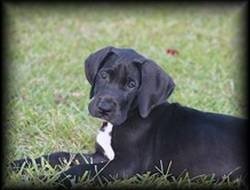
|

|
|||||||||||||||||||||||
|
| ||||||||||||||||||||||||
Great Dane CareThe Four Most Dangerous Dog ParasitesPart of Great Dane Care is knowing what is harmful to your dog, and how to prevent it. Parasites in dogs are very serious and may be life-threatening if not treated. There are many types of parasites, with some quite dangerous, but all are treatable. Heartworms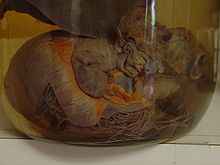 Heartworms (Dirofilaria immitis) can obstruct the blood vessels and chambers of the heart impairing circulation of the blood. This may result in damage to the heart, lungs, liver and kidneys and, in rare instances, cause sudden death. Heartworm is a parasitic roundworm (Dirofilaria immitis) that is spread from host to host through the bites of mosquitoes. The heartworm is a type of filaria, a small thread-like worm. The definitive host is the dog but it can also infect cats, wolves, coyotes, foxes and other animals, such as ferrets, sea lions and even, under very rare circumstances, humans. The parasite is commonly called "heartworm" because the adult reproductive stage of its life cycle resides primarily in the right ventricle of its host where it can live for many years. Heartworm infection may result in serious disease for the host. Prevention of heartworm infection can be obtained through a number of veterinary drugs. Preventive drugs are highly effective and when regularly administered will protect more than 99 percent of dogs and cats from heartworm. Most compromises in protection result from failure to properly administer the drugs during seasonal transmission periods. Great Dane Care is keeping your dog on his Heart Worm preventive medicine. Signs of InfectionMany dogs will show little or no sign of infection even after the worms become adults. These animals usually have only a light infection and live a fairly sedentary lifestyle. However, active dogs and those with heavier infections may show the classic signs of heartworm disease. Early signs include a cough, especially on exercise and early exhaustion upon exercise. In the most advanced cases where many adult worms have built up in the heart without treatment, signs progress to severe weight loss, fainting, coughing up blood and, finally, congestive heart failure. Great Dane Care involves being attentive to any type of different behavior from your Great Dane. Hookworms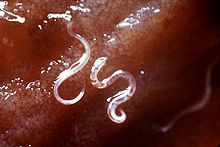 Hookworms attach themselves to the small intestines and draw blood from the dog. If not properly treated, they may cause anemia, hemorrhaging, shock and death. The hookworm is a parasitic nematode worm that lives in the small intestine of its host, which may be a mammal such as a dog, cat, or human. Hookworms are thought to infect more than 600 million people worldwide. The A. braziliense and A. tubaeforme species infect cats, while A. caninum infects dogs. Uncinaria stenocephala infects both dogs and cats. Dogs pick up hookworms either by eating the worm eggs deposited in dog feces or when worms from the ground penetrate the skin. A dog can become infested simply by walking on a lawn. Great Dane Care also involves cleaning up after your pet or other pets that deficate in your yard to prevent the spread of Hookworms. Ankylostomiasis is the disease caused by hookworms. It is caused when hookworms, present in large numbers, produce an iron deficiency, anemia, by voraciously sucking blood from the host's intestinal walls. Why Dogs Scoot? When dogs scoot, they drop their butts, put their back feet in the air, and pull themselves across the floor with their their front legs. In most cases, this comical behavior is caused by the irrtation of over filled anal sacs, grape-sized structures just inside the anus, usually, scooting dogs are just trying to empty the sacs. Only in rare cases do worms cause anal irritation or scooting. PreventionMoxidectin has been released in the United States as part of Advantage Multi (imidacloprid + moxidectin) Topical Solution for dogs and cats. It utilizes moxidectin for control and prevention of roundworms, hookworms, heartworms, and whipworms. Prevention is a major aspect in your Great Dane Care. If you use the right preventive measures it will help ensure the health of your Great Dane for years to come. Roundworms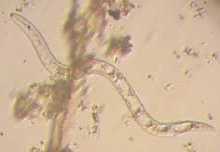 The Roundworm (Toxocara) is the common intestinal worm of dogs. It looks like spaghetti, thin, round, and up to eight inches in length. In adult dogs, roundworms in the intestine absorb nutrients from the surrounding fluid; then they mate and lay microscopic eggs. Once the eggs pass out of the dog in his stool, they hatch into larvae ready to infest another dog. The next dog becomes infested by eating the stool or grass contaminated with larvae. The time from egg-laying to larvae depends on the temperature. If it is hot, eggs can hatch in less than a day. If it is cold, they can stay dormant for a month. These worms can actually tell the difference between a puppy and an adult dog, and change their travel routes accordingly. A larva eaten by a puppy less than 3 months old does not develop into an adult worm right away, it first has to go on a walkabout. The larva burrows through the pup’s intestinal wall, tunnels through the liver, passes through the diaphragm, and finds its way into an airway in the lung. Once there, it is coughed up and swallowed, returning it to the intestine where it can mature and produce eggs. If enough worms migrate at one time, puppies can become quite ill. When infestations are severe, puppies may vomit up a pile of writhing worms or pass them in their stools. In adult dogs, Toxocara larvae follow a very different path. They burrow through the intestinal wall as in puppies, but they end their journey in muscle tissue where they enclose themselves in cysts. These lay dormant forever, with one important exception: If a larva is lucky enough to encyst in a breeding female dog, it gets a reprieve. The hormonal changes of pregnancy trigger the larva to emerge. It then goes to one of two places, either into the uterus and directly into a puppy, or into the mammary glands where it ends up in the dam’s milk. These two mechanisms explain how puppies may be infested at a very young age, or even be born with roundworms. TreatmentThe nice thing about worms is that they are easy to treat. Many deworming medications are available, from your veterinarian and at pet-supply stores. But because each product kills only certain species of worms, it is important to give the right one. If you are sure of which type of worms your dog has, pick a product developed specifically to kill them. If you do not know, ask your vet to check a fecal sample. Or you can use a broad-spectrum dewormer to treat all types of worms at once. You should treat your puppies every two to four weeks until they reach 16 weeks of age. Adult dogs should continue to be dewormed on a regular basis. If the risk of reinfestation is high, or if there is a concern about transmission of worms to children, most dogs can be dewormed safely once a month. Giardia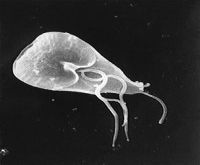 Giardia is a parasite dogs may contract from contaminated water such as lakes, rivers and ponds. Giardia live in the dogs intestines eating the lining which results in inflammation, weight loss, bloating and mucus covered stool. If not treated, may cause other serious health problems. Giardia lives inside the intestines of infected humans or animals. Individuals become infected through ingesting or coming into contact with contaminated food, soil, or water. The Giardia parasite spreads when a person accidently swallows it, which can originate from contaminated items and surfaces that have been tainted by the feces of an infected human or animal. Consuming unsanitary water or food is also another way in which the parasite can transfer from being to being. Reference: Wikipedia the Online Encyclopedia Flea Pest Control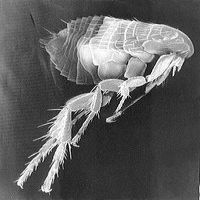 Flea Facts: With these facts and knowing fleas carry so many diseases that are harmful and deadly to your pet, keeping them on a preventive is a must. Click here to get your free pdf ebook on Flea and Ticks. More is not better. Never use more than one flea product on your pet without your veterinarian’s approval. Using a shampoo or dip along with a topical or oral flea product can cause your pet to take in too much of the active ingredients in these products, leading to a bad reaction or even poisoning. When it comes to Great Dane Care one of the most important factors is Flear and Tick care. Taking Your Dogs Temperature You will need a rectal thermometer to take your dog's or cat's temperature. You do not need a special 'dog' or 'cat' thermometer – you can use one designed for human use. Shake down the thermometer until the reading is 96°F or less. Lubricate the thermometer with some vaseline or lubricating jelly. Grasp your pet's tail at the base and raise it. Hold it firmly so your pet will not sit down. Reassure and talk quietly to your pet during the whole procedure. This will help keep your pet calm, relaxed, and holding still. Taking a dog's temperature Gently insert the bulb portion of the thermometer into your pet's anus. It works best if you use a twisting motion. Insert the thermometer about 1 inch in cats and small dogs, and up to three inches for giant breed dogs. Leave the thermometer in place for 1-2 minutes. Then remove it and wipe it with gauze or a cotton ball. Read the temperature at the end of the column of mercury. Clean the thermometer with rubbing alcohol and store it safely. Temperature - 100.5 to 102.5 This is the normal reading for your pet. Arthritis In Dogs, Tips for ReliefAsk your veterinarian about these natural ingredients and how to incorporate them into your dogs diet. ~Ascorbic acid, or Vitamin C, aids in bone strength and helps the body process glocosamine. ~Yucca increases the body's cortisone production to relieve pain. ~Bromelain enzyme extracted from Pineapple stems reduces pain and swelling. ~Perna mussels, or green-lipped mussels, contain anti-inflammatory andantihistamine compounds for osteoarthritis, plus substances believed to relieve rheumatoid arthritis. ~Aloe Vera reduces inflammation. -by:Holly Ocasio RizzoWhat is Parvo?By Wendy C. Brooks, DVM, DipABVP Parvoviruses are a large group; almost every mammal species (including humans) seems to have its own parvovirus. Fortunately, each virus is pretty specific about what animals it can infect (i.e. the pig parvovirus will not infect people, the canine parvovirus will not infect cats, etc.) The canine parvovirus will affect most members of the dog family (wolves, coyotes, foxes etc.) Parvoviruses are smaller than most viruses and consist of a protein coat (a capsid) and a single strand of DNA inside. It is hard to believe that such a simply constructed organism could be so deadly; however, this virus has proved especially effective at infecting rapidly dividing host cells such as intestinal cells, bone marrow cells, cells of the lymph system, and fetal cells. Parvoviruses are not enveloped in fat the way many other viruses are. This makes parvoviruses especially hardy in the environment and difficult to disinfect away. While the parvoviruses of other species have been well known for decades, the canine parvovirus is a relative newcomer. The original canine parvovirus, discovered in 1967 and called CPV-1 did not represent much of a medical threat except to newborn puppies but by 1978, a new variant, CPV-2 appeared in the U.S. This newer version seems to represent a mutation from the feline parvovirus (which is more commonly known as the feline distemper virus). Because this virus was (and is) shed in gigantic numbers by infected animals, and because this virus is especially hardy in the environment, worldwide distribution of the virus rapidly occurred. At this time, the virus is considered to be ubiquitous, meaning that it is present in EVERY ENVIRONMENT unless regular disinfection is applied. Attempting to shield a puppy from exposure is completely futile. In 1978, no dog had any sort of immunity against this virus. There was no resistance and the epidemic that resulted was disastrous. To make matters worse, a second mutation creating CPV-2a had occurred by 1979, and it seemed to be even more aggressive. Vaccine was at a premium and many veterinarians had to make do with feline distemper vaccine as it was the closest related vaccine available while the manufacturers struggled to supply the nation with true parvo vaccines. Over thirty years have passed since then. The most common form of the virus is called CPV-2b. Virtually all dogs can be considered to have been exposed to it at least to some extent, which means that most adult dogs, even those inadequately vaccinated, can be considered to have at least some immunity. It is also worth mentioning the new particularly virulent strain of parvovirus: CPV-2c, which is rapidly becoming the second most common form of canine parvovirus. CPV-2c was discovered in the year 2000 and is able to infect cats. Cats vaccinated against feline distemper can be considered protected. Currently available vaccines cover all variants of canine parvo including CPV-2c as do all the commercially available diagnostic test kits. For more specific information about Canine Parvovirus-2c, see the American Veterinary Medical Association's FAQ. Parvoviral infection has become a disease almost exclusively of puppies and adolescent dogs. Parvoviral infection must be considered as a possible diagnosis in any young dog with vomiting and/or diarrhea. With proper hospitalization, survival rates approach 80%. First Aid Kit for Your Dog
Always remember that any first aid administered to your pet should be followed by immediate veterinary care. First aid care is not a substitute for veterinary care, but it may save your pet's life until it receives veterinary treatment. Click here to download a PDF to learn CPR for your animal. This is VERY important and every pet owner should learn how to do this! Dog Houses Shop FidosHouse.com for dog houses. References and Links for Great Dane CareVet Info VetInfo - Veterinary Medical Information for Dogs and Cats The Merck Veterinary Manual The Merck Veterinary Manual Online is published on a nonprofit basis through a cooperative effort of Merck & Co, Inc. and Merial Limited as a free service to the veterinary profession. Pet Health 101 Get the answers you need for your pets health questions. Bayer Health Care Flea control for dogs and cats.  Table of Contents |  Click Here To Visit Kittys Corner Great Dane Care of Flea Bite HypersensitivityFlea bite hypersensitivity is an allergic reaction caused by exposure to flea saliva. When fleas bite and feed on dogs or cats, their saliva can cause an allergic reaction in the skin. Signs of TroubleIn many cases, dogs and cats with flea bite hypersensitivity will bite the base of their tail and scratch frequently. Many dogs experience characteristic hair loss or thinning hair above the tail base that may become more generalized and extend to the inside of the thighs, or abdomen. Dogs may occasionally develop secondary skin infections and other skin lesions. Cats may develop small circular crusts at the base of the neck or base of the tail and/or red raised areas on their skin. Click here to get your free pdf ebook on Flea and Ticks.DiagnoisDiagnosis is based on patient history, physical examination, skin testing with flea antigen, and response to treatment. The presence of fleas or flea dirt along with the characteristic pattern of hair loss is also a helpful finding. The absence of fleas does not rule out a diagnosis because some sensitive animals may require only periodic flea exposure to develop skin problems. Your veterinarian may need to perform additional diagnostic tests to rule out other secondary skin issues caused by flea exposure and the allergic reaction they caused. Treatment and PreventionSince fleas cause the hypersensitivity, flea control is essential. Even if you no longer see fleas, you should continue use of the year-round flea control product because immature flea stages may be lurking in your environment. Medication may also be provided to help treat the skin irritation associated with flea bite hypersensitivity and make your pet more comfortable. Checking Dogs PulseThere are several areas on the dogs body where you may be able to feel the pulse. A pulse occurs with every heart beat. Sometimes, you can just place your hands low on your dogs chest, near the elbow joint, and feel the heart beats. You can count how many beats you feel in 15 seconds and then multiply it be 4. That will give you the pulse. A second place to find the pulse is high on the inner side of the thigh. You will be feeling for the femoral artery. Place two fingers on the middle of the thigh near where the leg joins the body. What you feel is the 'femoral pulse'. It is always best to use your fingers to feel the pulse. If you use your thumb, and press too hard, what you feel will actually be your own pulse. The normal pulse for a dog ranges from 70 to 180 beats per minute. In general, the larger the dog, the slower the pulse. Puppies generally have a fast pulse, up to 220 beats per minute. The pulse of a dog is not always steady. Sometimes, the rate changes as the dog breathes in and out. The pulse will be faster on inspiration and slower on expiration. This is normal and is called sinus arrhythmia. Signs that Your Dog Should Visit the Vet
Great Dane Health CareThe First Check Up You will want to take your new puppy in for its first check up within 48 to 72 hours after acquiring it. Many breeders strongly recommend this checkup and so do the humane shelters. A puppy can appear healthy but it may have a serious problem that is not apparent to the layman. Most pets have some type of a minor faw that may never cause a real problem. The health of your Great Dane depends on your consistent Great Dane care and that of a knowledgeable veterinarian. 
~Kittys Corner~I have a Female Great Dane and her name is Kitty. She will be 2 in July '10. Her mother is a Blue Dane and her dad is a Black Dane. This is a picture of her here and there are lots of pictures of her on this website. This space is called Kittys Corner because when ever I am at my computer working (which is most of the time) Kitty is laying or sitting beside me with her head on my lap. So I made her a corner so she can voice what is going on in her world. ~Enjoy~The weather is so warm and sunny. I was getting tired of the cold and being stuck in the house. Now mom has been back taking me on our walks I missed our walks. Have you been doing anything fun lately? Will you send me your pictures so I can see them? Mom even said something about starting a contest. How fun! So start taking some pictures, or if you already have some, send them in so I can see them. Send in a Picture 
| |||||||||||||||||||||||
| | ||||||||||||||||||||||||
Great Dane Care and Advice Beginning Welcome to the World of the Great Dane.This website strives to bring you the latest information on Great Danes. The content is updated often so make sure and bookmark this site so you can keep up to date on the information. Link To UsReturn to top The Content of this Website is intended as General Information and is NOT Professional Advice. | ||||||||||||||||||||||||
| | ||||||||||||||||||||||||





